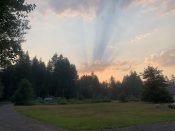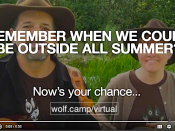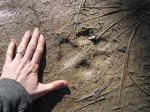Truths & Myths • Facts & Common Sense • Practicalities & Fantasies
 So many people argue about climate change: whether it is happening, what is causing it, what to do about it, and how to deal with it. Even professional advocates of reducing atmospheric greenhouse gasses sometimes only have a simplistic understanding of the greenhouse process, and that elementary-level understanding can undermine their own advocacy.
So many people argue about climate change: whether it is happening, what is causing it, what to do about it, and how to deal with it. Even professional advocates of reducing atmospheric greenhouse gasses sometimes only have a simplistic understanding of the greenhouse process, and that elementary-level understanding can undermine their own advocacy.
For instance, advocates often say “plant trees” to address climate change, and that works for those of us who were already environmentalists. But if advocates explained the amazing process by which all plants take greenhouse-producing carbon out of the atmosphere, then I think even the most ardent opponent would understand and agree with how burning carbon causes climate change; once their denial stops, then we can tell the difference between those who were simply deniers, and those who simply don’t care that climates are changing.
I’m going to use my experience as a teacher to separate the wheat from chaff, and break down exactly what I’ve seen brings students through the noise and into a clear understanding of the science, politics, and personal effects of burning carbon. Myths are wonderful for generating social well-being, but tackling societal problems requires finding evidence which leads the real truth, not preconceived common sense. Common sense is comforting, but it took facts to convince people that the earth actually goes around the sun and not visa-versa, just like it will take facts to show people that trees mostly grow out of the air, not out of the ground.
Fantasies are a traditional human step through the denial phase of confronting problems, like the past 10 years when Peak Oil popularity gave hope that a market-based approach to carbon-caused climate change would be found. But practicalities eventually become evident, like now when it’s clear that a fight will be necessary to keep fossil fuels in the ground if we want to reverse climate change. Some will not want to reverse climate change, however, because either 1) they are in denial, or 2) they benefit from it, or 3) they have weighed the changes and gambled that they won’t be affected by it.
Ready to argue carbon and climate? Pop Quiz!
Updated answers currently being re-written in advance of our next Earth Day Climate Change Training – Lifestyle, Debates, Emergencies & Carbon class, or in the meantime, bring us to your school or facility as part of a custom designed program on this topic.
How is coal and oil geologically created?
What are bogs as compared to other wetlands?
How is charcoal or “biochar” created and how does it sequester carbon?
Where do trees and other plants get most of their mass?
Which tree or plant can best sequester carbon in your environment?
Where is most carbon sequestered in the world every day?
What has been the quantity of carbon in the atmosphere over time?
What have global temperatures been in relation to carbon in the atmosphere?
When do temperatures change in relation to carbon increases and decreases in the atmosphere?
Why did ocean and atmospheric temperatures rise between 1998-2012, while surface temperatures rose very little?
What does water acidity have to do with carbon, and what has been the historic change in ocean acidity?
What has been the change in the percentage in atmospheric water vapor over the past century?
What were the causes of dramatic climate shifts historically?
What caused the mass extinction of mega-fauna at the end of the last ice age?
How many climate scientists question whether human-caused increases in atmospheric carbon cause global warming / climate change?
Do ethanol and other biofuels decrease carbon emissions?
What is the difference between burning petroleum diesel, biodiesel, and vegetable oil in diesel-engines?
What is Peak Oil, when is it projected to happen, and is that the market-based solution to developing non-fossil-fuel energy sources?
What is Fracking, how has it revolutionized oil and gas production, where is it taking place now, and where is it projected to take place in the future?
Would you be willing to live near or downstream/downwind from oil and gas fracking wells, open pit coal and mines, fracking sand mines, fossil fuel refineries and power plants, or near fossil fuel transport infrastructure?
Are there any other full solutions to reversing climate change other than leaving fossil fuels in the ground?
Who will be affected the most by global-warming climate changes?
Projects to Understand Carbon & Climate
 Build a Greenhouse & Reflecting Sunlight – At our Climate Change Training – Lifestyle, Debates, Emergencies & Carbon, we bring a small greenhouse called a “cold frame” to class, and do a couple experiments with it, including measuring the temperature when black soil is in it, when green sod is in it, when water is in it, and when a white reflective cloth is placed inside. Why? Most people understand the greenhouse effect, but it’s also important to understand 1) the difference between having the polar ice caps reflect sunlight vs. blue water absorbing it, 2) the difference between having high amounts of evaporative water in the atmosphere vs. “dry” air, and 3) the difference between tarred ground and roofs vs. green-plant-covered surfaces.
Build a Greenhouse & Reflecting Sunlight – At our Climate Change Training – Lifestyle, Debates, Emergencies & Carbon, we bring a small greenhouse called a “cold frame” to class, and do a couple experiments with it, including measuring the temperature when black soil is in it, when green sod is in it, when water is in it, and when a white reflective cloth is placed inside. Why? Most people understand the greenhouse effect, but it’s also important to understand 1) the difference between having the polar ice caps reflect sunlight vs. blue water absorbing it, 2) the difference between having high amounts of evaporative water in the atmosphere vs. “dry” air, and 3) the difference between tarred ground and roofs vs. green-plant-covered surfaces.
Plant Trees That Grow Fast & Decompose Slowly – We believe that planting cedar trees may be the best way to sequester carbon in Western Washington, Oregon & British Columbia over the long term. Why? As participants learn in class, cedar trees sequester a high amount of carbon from the atmosphere, and further, it takes a cedar tree decades, if not centuries, to decompose, making it the best sequestering plant in our bio-region. During this part of class, you will learn how to plant trees so that they survive and thrive.
Make Biochar Charcoal – Paradoxically, a strategy to reduce carbon emissions into the atmosphere is to burn wood and other debris. If we burn wood at the right temperature and for the right amount of time, we can limit the amount of smoke it produces, and create charcoal or “biochar” which doesn’t decompose very well, and therefore, does not release carbon into the atmosphere for a long, long time – aka: sequestering carbon. The math on this process, including the difference between “activated” and “inactivate” biochar, is currently being researched. In class, we bring a small “bio-char” charcoal-making stove to class, and participants bring home charcoal that they make.
Audit Your House – In class, we bring along some simple gadgets to show how easy it is to “audit” your home for energy conservation. For instance, a laser-pointing thermometer costs $5 and will tell you in seconds where you are losing heat in your home. Even better, you can often get free home energy audits from energy companies which are mandated to do this for home owners. The idea is to save you money, especially on the west coast where much of our electricity comes from dams whose carbon footprint was expended decades ago.
Instal Solar Panels – What? We don’t get enough sun! Actually you do, because solar technology is no longer stuck in Ronald Reagan’s world of 1984. In class, we bring a small solar panel to class along with a battery to show how sunlight is converted to electricity, and we see which appliances use the most energy. We think you will be surprised about the many ways to reduce energy consumption. Perhaps most surprising is how inexpensive it has become over the past few years to convert your home to an energy producer. In fact, many people are making money on it. Can’t afford the investment? Rent it for the same price you pay now for electricity!
Get Around Differently – Riding bikes, taking buses and trains, and getting rides are coming back into style due to smart phone technology. Why? In class, we explain how teenagers are driving less! We’ll also bring going to bring along some biodiesel-making kits as an option to work with, and we’ll discuss how the making of biodiesel and other biofuels have positive and negative effects on carbon emissions. Driving electric cars is excellent for reducing carbon in areas where electricity is produced with established hydroelectric/wind/solar power like in the Northwest, and if you really can’t to change your lifestyle to drive less, then how about a hybrid gas plug-in vehicle?
Prepare for Climate Emergencies – Humankind has always had to deal with weather disasters, but due to increased temperatures and more water in the atmosphere, we have now entered an era where we have to deal with them multiple times per year. The mega fires that came once per decade now occur 2-3 times per summer in the western US. Same with our Atlantic hurricanes, and Midwest tornadoes. No one denies that. So it is incredibly important, now more than ever, that we develop emergency response preparations as a part of daily life. In class, participants learn the best way to respond to an emergency using the Order of Survival, and the best way to prepare for climate disasters, including getting involved with CERT and other community systems.
Join the Fight to Keep Carbon in the Ground – Supporting 350.org, Sierra Club & Others; Electing Environmentally-Aware Politicians; Lobbying for a Carbon Tax; Stopping Oil & Coal Train Shipments; Shutting Down Gas Pipelines; Converting Gas & Coal Terminals.
Chris Chisholm is founder of Wolf Camp and the Wolf College, and he teaches a class entitled Climate Change Training – Lifestyle, Debates Emergencies & Sequestration annually in Portland for the Sierra Club, in Tacoma for The Mountaineers, as well as in Seattle at the Good Shepherd Center. Chris also runs the Wolf College Climate Change Debate Camp for youth in the summer. Custom-designed classes are also available on this theme.








